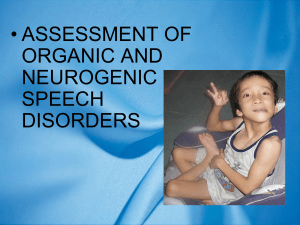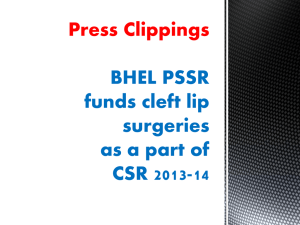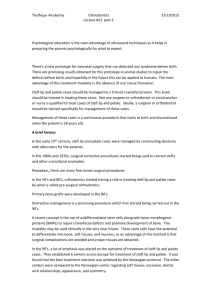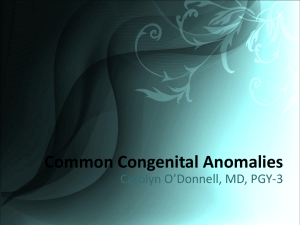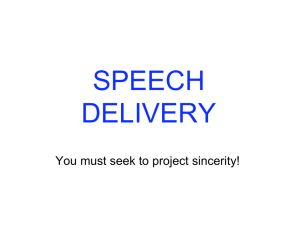Cleft Lip Brochure - University of Michigan Health System
advertisement
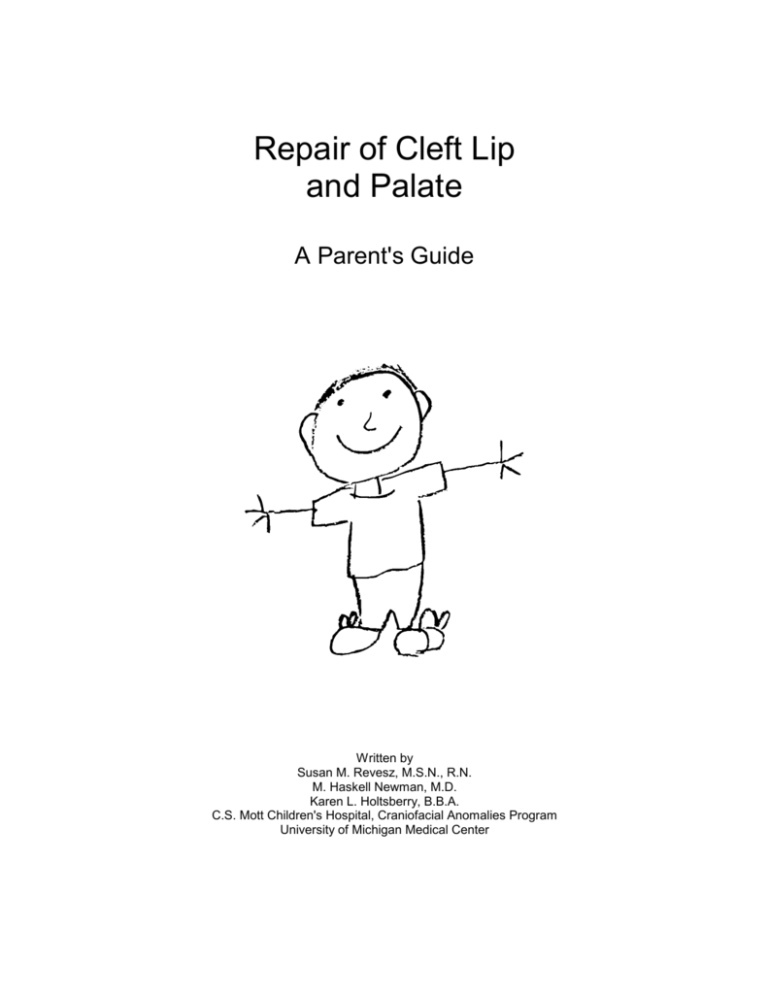
Repair of Cleft Lip and Palate A Parent's Guide Written by Susan M. Revesz, M.S.N., R.N. M. Haskell Newman, M.D. Karen L. Holtsberry, B.B.A. C.S. Mott Children's Hospital, Craniofacial Anomalies Program University of Michigan Medical Center Introduction Parents of babies born with clefts have many questions and concerns, including the cause of the birth defect, the health of the baby, and the timing and sequence of operations and non operative treatments that the child will undergo. The purpose of this booklet is to provide parents and families of children with clefts with an educational tool and resource regarding the repair of the cleft lip and palate and subsequent treatment. Cleft lip and palate refer to an abnormal opening of the lip and/or the roof of the mouth (palate). Lips form together as one piece during the sixth week of pregnancy, and the palate during the last part of first trimester. Therefore it is possible to have cleft lip alone, or with a cleft palate as well. It is unclear what causes clefts, however they may be the result of environmental and genetic conditions, or a combination of both. Cleft lip and/or palate is a fairly common birth defect, affecting roughly 1 per 1000 Caucasians, 1.7 per 1000 Asians and .4 per 1000 Blacks. The goals in the treatment of cleft lip and palate are first, to ensure the physical health including the growth and development of the child with a cleft. The second goal is to enable the child with a cleft to obtain the same type of educational and employment opportunities as the child without a cleft, mainly because of an enhanced ability to communicate. The final goal is to provide the child with an acceptable cosmetic outcome. The team approach is the most beneficial to the child born with a cleft, because these children have a broad range of treatment needs that no one specialist can fulfill. Typically, a team evaluation of the child takes place between the ages of one and three years of age. The child with a cleft may undergo four to five operations spanning the years from infancy to young adulthood. These operations may include primary lip repair, primary palate repair, pharyngoplasty, alveolar bone grafting, upper and or lower jaw surgery, and rhinoplasty. Feeding the Infant with a Cleft A cleft lip or palate makes the feeding of a baby more difficult, but not impossible. Your baby must gain weight in order to grow and develop, and in order to begin repairs of the cleft. A speech pathologist will be available to help you with day to day questions you might have about feeding your baby. The major problems with feeding a baby with a cleft are problems with sucking and with formula coming through the nose. The baby with a cleft will want to suck like any other baby, but has problems making an airtight seal around a nipple. Begin with a regular nipple, and if the baby can't get enough to eat, try a preemie nipple, which is softer than a normal nipple. Enlarging the hole in the nipple by cross-cutting it with a razor blade will increase the flow of formula and make it easier to feed. In addition, squeeze bottles such as the "Mead Johnson Nurser®" or "Haberman Feeder®" can be tried. The team-feeding specialist will help you choose a bottle that is appropriate for your baby. It may be best to offer small frequent feedings to the baby. The baby with a cleft swallows more air while feeding than a baby without a cleft. Therefore, they need to be burped frequently. In addition, feeding the baby in the sitting position may prevent formula from coming out of the nose, and from swallowing too much air. Milk and other food debris can be cleaned from the area of the cleft by offering the baby sips of water from the bottle, or by wiping with a damp cloth. Pacifiers may be used as with any baby. Solid food can be introduced to the baby with a cleft at the same time as the infant without a cleft (at about six months of age). If the baby seems not to be gaining weight, or if there seems to be much difficulty in feeding the baby, it is important to contact the teamfeeding specialist. Cross cut nipple Baby fed with squeeze bottle feeder Ear Problems A baby born with a cleft palate is prone to ear infections. It is unclear why, although the problem may be related to the inability of the ear to drain properly. This allows a build up of fluid, which may become infected. If left untreated, this infection can lead to permanent hearing loss. Your child will be monitored frequently for the presence of ear infections and hearing loss. Ear infections can be treated with antibiotics, and if the infection does not clear or fluid remains, tubes will be placed in the eardrum, which allows drainage of the infected fluid. The ear tubes are often placed at the same time as the lip or palate repair. Your child's ear will not look any different from the outside. Eardrops may be prescribed for a short time after the placement of the ear tubes. After placement of the tubes, your child's hearing and the functioning of the tubes will be tested at recommended intervals. Hearing test. Illustration of ear tube placement. Maxillary Orthopedics The first stage in the repair of a cleft lip and palate may be "maxillary orthopedics." The child with a cleft lip and palate may have a wide gap between the segments of the alveolus (gum), and palate. Maxillary orthopedics is the expansion and realignment of parts of the gum and palate with removable appliances. These devices change the anatomy and make it suitable for surgery The devices may be used to decrease the size of a wide cleft or to treat a prominent premaxilla. Pressure against the protruding upper gum or “premaxilla” positions it enough to permit surgical closure of the lip. This is done in conjunction with a dentist who makes impressions of the face and mouth of the child and designs the needed devices. On occasion, additional devices are used, such as elastic bands that are taped over the upper lip to aid in the alveolar positioning. Prominent premaxilla. These devices are placed when the child is a couple of weeks to a month old. "Latham devices" are used to decrease the size of a wide cleft and make the lip repair easier. The Latham device is inserted in the operating room under general anesthesia. Prior to the insertion of the device (and any surgical procedure), the baby will have a physical exam and have blood drawn for tests. Immediately after surgery, the child may be fussy and may have a difficult time taking a bottle. The child will be medicated for pain. There may be a string attached to the tongue to enable the tongue to be brought forward in case the child has respiratory distress. You will be instructed on the care of the device, including tightening, cleaning, and watching for signs and symptoms of infection. The device will be removed before the lip repair. Latham device to position unilateral cleft palate. Lip Repair The cleft of the lip can be unilateral or bilateral. The repair of the child's lip generally takes place at age 10 to 12 weeks, although optimum timing of repairs may differ from child to child. The repair of the cleft lip is done in the operating room under general anesthesia. There are several methods of repairing the cleft lip, and the surgeon will choose the type of repair that is appropriate depending on the type of cleft lip your baby has. In the cleft lip operation, incisions are made and the pieces are brought together to form a full lip. After surgery, the child's lip may be red with some swelling. He may have a device on his face called a "Logan's bow". This is a metallic device that is taped to the cheeks to lessen the tension on the suture line on the lip, and to protect it from being bumped or rubbed. Postoperatively, the child will have an IV, and may need to sleep in a crib with the head of the crib propped up to decrease swelling. Unilateral cleft lip. The feeding of the child will also change after surgery. An older child may be fed with a cup, and a baby should be fed with a syringe attached to a piece of rubber tubing or the side of a spoon. In some cases, it may be acceptable to continue feeding the baby with the flexible Mead Johnson Nurser® Breast-feeding may not be possible immediately after surgery. The child's pain can be managed with medication. After an operation, there is usually a change in the child's behavior, including fussiness and refusal to eat with the new feeding method. Holding and rocking the baby are comfort measures that can be provided. The child may have soft arm restraints on to prevent scratching at the suture line. These restraints, called "No no's", are necessary after surgery, and will need to be worn for ten to fourteen days after the surgery. They can be removed, one at a time, every two to three hours in order to exercise the baby's arms. Bilateral cleft lip. No dressing over the lip is needed, but an antibiotic ointment will be applied. The lip sutures should be cleaned thoroughly and gently. Crusted drainage may be removed using hydrogen peroxide diluted with water. A thin layer of antibiotic ointment should be kept on the suture line at all times. The child can be discharged from the hospital if he is taking liquids well (usually in one or two days). Prescriptions will be written for pain medication (usually Tylenol with codeine), an antibiotic, and ointment for his suture line. Sun exposure should be minimized for six months to reduce darkening of the scar. There will be a scar on your child's lip that will become less noticeable overtime but will never completely disappear. Baby in "No no's" restraint Unilateral cleft lip repair. Repaired unilateral cleft lip. Bilateral cleft lip repair. Repaired bilateral cleft lip. Palate Repair The repair of the cleft palate is usually done at age six to eighteen months of age. Although the child may look normal from the outside, the cleft palate should be closed for several reasons, namely to improve speech and to separate the mouth and the nasal cavity. More than one operation may be necessary to close the cleft palate. The cleft palate operation is done under general anesthesia in the operating room. The operation involves making several incisions in the pieces of the palate and putting the pieces of the palate together in several layers; the layer which is the floor of the nose, the muscles in the middle of the palate, and the skin that is the roof of the mouth. The child may be hospitalized for about two to three days after surgery Post operatively, the child Cleft palate. will have a IV and may be on antibiotics. The child may be in a mist tent with the head of the bed up, or in a car seat to make it easier to breath. The child may have a stitch with a long thread on his tongue in order to pull the tongue forward if the child should have airway distress. Nothing hard should be put into the mouth, but it is acceptable to bottle feed the child, or to let him drink out of the edge of a cup. Feedings should be finished with plain water, to cleanse the palate. The sutures used to close the repair are made of material that will dissolve, so no sutures will have to be removed from the roof of the mouth. You should call the clinic if the child develops a fever, if there is bleeding or drainage from the mouth, and if the child is inconsolable after usual comforting measures, such as rocking and pain medication Palate repair. Lip and Nose Revision Nasal surgery ("rhinoplasty") and/or lip surgery ("revision cheiloplasty") may be necessary to improve the appearance and function of the nose and lip which have been distorted with growth after the initial surgery. The nose may appear flattened, or there may be asymmetry of the nose. There may be nasal obstruction due to a small nostril or a deviated septum. Surgery to revise the appearance of the lip and/or nose may take place before the child starts school or during the teenage years, depending on the recommendations of the plastic surgeon. Your child's nose will be packed with gauze or splints, which are removed a few days after surgery. There may be mild bruising and swelling around the nose and eyes. After nasal surgery, there should be no bending, lifting, straining, or vigorous activity for about two weeks. Your child's nose may be covered with a plaster splint, which should be kept dry. This splint will be removed after about a week. A snuffer made of gauze can be taped below the nose to catch any drainage. Call if your child has extreme swelling or bruising, if there is persistent pain not relieved by the medication, or if your child has an elevated temperature or bleeding. Nose deformity. There will be sutures on the child's lip after lip revision surgery, with some swelling of the lip. These should be lightly coated with antibiotic ointment. No special diet is necessary after lip revision surgery, but for small children it may be necessary to avoid utensils, which might disrupt the repair. Nose after surgery. Pharyngeal Flap/Pharyngoplasty Children with repaired cleft palate may have a resulting condition referred to as "VPI" (Velopharyngeal Incompetence). This means that too much air escapes through the nose during speech, resulting in nasal speech. This occurs because the repaired soft palate is too short or does not move adequately This condition is diagnosed primarily by the trained ear of the speech pathologist. However, special diagnostic procedures such as nasoendoscopy and videofluoroscopy of speech may be required to directly visualize the soft palate during speech. This helps in directing the type of intervention, which is the most appropriate. With the goal of successful communication for the child with cleft lip and palate, the speech pathologist regularly monitors the development of using and understanding language and the development of speech abilities including pronunciation of words Pharyngoplasty presurgery. (articulation), the sound of the voice and the amount of nasality during speech. When necessary, recommendations for speech therapy are made based on the child's specific needs. Operations to improve the function of the soft palate are the "pharyngeal flap" or "pharyngoplasty" procedures. In these operations, some of the tissue from the palate and the back of the throat are repositioned to help close off the escape of air through the nose. Postoperatively the child may be in the hospital for three or four days. A soft diet is required due to throat pain and to prevent injury to the repair. The child may be on antibiotics. The child may have earaches due to swelling in the throat. Normal activities can be resumed in one or two weeks. Speech therapy is usually still required postoperatively in order to teach the child to speak with newly designed structures. Pharyngoplasty postsurgery. Alignment of the Teeth Dentistry/Orthodontics Proper care of the teeth is important. Your child should begin dental care in infancy; wiping baby teeth with gauze and eventually working up to a soft baby toothbrush. Your child should begin to see a dentist at regular intervals once baby teeth are in, which is usually at about three years of age. The teeth of a child with a cleft lip or palate may erupt in poor position, and some may not come in at all. When the time is right, the orthodontist aligns the teeth using braces, which bring them into normal position. Alveolar Cleft Bone Grafting A cleft defect can involve the teeth and gums. A child with cleft palate may need surgery after the initial cleft palate repair to replace missing bone in the front of the mouth and the roof to the mouth. Alveolar cleft presurgery. The "alveolus" is the bony part of the upper jaw and lower jaw that contains the teeth. The placement of bone to this area is referred to as "alveolar cleft bone grafting" (ACBG). Bone is taken from the bones of the hip or skull, and placed in the area of the cleft in the gum. This enables the teeth, which may not have erupted a stable support to erupt through. There is also added support and improved contour if a bridge is needed to fill in missing teeth. Postoperatively, the child may have a swollen lip and mouth on the side of the bone graft. The sutures inside of the mouth will dissolve. There will be sutures on either the skull or the hip. These will be removed about a week after surgery. Alveolar cleft postsurgery. Your child will be discharged from the hospital when he can eat and drink, and when pain is controlled with oral pain medication. Your child will be on a soft diet for several weeks and should not put any hard object, such as eating utensil or straws, in his mouth. Orthognathic (jaw) Surgery Children who have had cleft lip and palate and subsequent repairs may have a resulting facial imbalance, and their teeth may not fit together properly. In addition to an improper "bite", the upper lip may not project properly. "Orthognathic surgery" refers to surgery to change the position of the upper and/or lower jaws, allowing the teeth to fit Presurgery. together properly and giving the face the correct balance. This surgery is generally delayed until the child is a teenager. After this operation, your child may have his teeth wired together and may be on a liquid diet for several weeks after surgery. His face and lips will be swollen and a special cream may be prescribed for his lips. Liquid pain medication will be prescribed (possibly Tylenol or Tylenol with codeine) as necessary. You will have the opportunity to speak with a nutritionist after your child's surgery in order to get ideas for a "no chew" diet. Postsurgery. Summary One in 700 babies born in the United States this year will have cleft lip, cleft palate or both. The Craniofacial Anomalies Program at the University of Michigan Medical Center began as the Cleft Palate Center more than 70 years ago and has become one of the largest programs in the country. Experience shows that surgical correction alone is not sufficient to ensure the physical and emotional well being of children born with clefts and other craniofacial problems. Nor is it possible for a single physician, dentist or therapist to evaluate and treat special medical, dental, educational, psychosocial and communication needs. Our multidisciplinary approach was developed in 1955. The team has grown to include 47 members from 22 medical and dental specialties, who are experienced in the care of children with cleft lip and palate. Many disciplines are involved in treating the children in our program, including Plastic and Reconstructive Surgery, Oral and Maxillofacial Surgery, Otolaryngology, Orthodontics, Audiology, Speech Language Pathology, and Pediatrics. We serve patients of any age with cleft lip and palate. For information regarding our program, please write the: Craniofacial Anomalies Program University of Michigan Medical Center, 1500 East Medical Center Drive, F7859 Mott, Box 0219 Ann Arbor, Michigan, 48109-0340 or call 1-800-U-OF-MCAP/1 -800-863-6227. Other resources include the Cleft Palate Foundation (I -800-24-CLEFT) and Aboutface (1-416-593-1448). Many of the cleft lip and palate problems we treat occur because of multiple factors over which one has little control. It is important to understand that our team has a great deal of experience in taking care of children with cleft lip and palate and the outlook for these children in terms of appearance, function, and psycho social well being is excellent. Definitions Alveolus: The bony part of the gum through which teeth erupt. Maxilla: The bone that forms the upper jaw. Alveolar bone graft: An operation in which bone is taken from one part of the body, usually the hip, and put into the gum in the area of the cleft. Palate fistula: A small opening in the palate that may occur after cleft palate surgery. Cleft lip: Separation of one side (unilateral) or both sides (bilateral) of the lip. Pharyngeal flap: An operation in which a piece of tissue from the back wall of the throat is attached to the soft palate in order to improve speech. Cleft palate: A separation in the palate (roof of the mouth) that extends into the nasal cavity. Pharyngoplasty: An operation in which tissue from the back of the throat is rearranged in order to improve speech. Columella: The piece of tissue located between the nostrils. Soft palate: The mobile, back part of the roof of the mouth. Complete cleft lip: Cleft that includes the lip, possibly the dental ridge (alveolus), and extends into the nasal cavity. Submucous cleft: A cleft of the soft palate that is not visible at birth. In this defect, the muscles of the soft palate are not joined even though the lining of the roof of the mouth is intact. Hard palate: The hard, bony part of the roof of the mouth. Incomplete cleft lip: Cleft that includes only part of the lip, with a bridge of tissue spanning the cleft side. Malocclusion: A condition in which the upper and lower teeth are not properly aligned. Mandible: The bone that forms the lower jaw. Velopharyngeal incompetence: Difficulty closing off the nose from the mouth while speaking, allowing too much air to escape through the nose, causing a speech defect. Acknowledgements Special thanks to Mary Berger, M.S., C.C.C., who made contributions to this text. We would like to acknowledge with gratitude our patients and their families, and the many health care professionals who contribute to their care. This booklet was funded in part through a grant from the FRIENDS of the University of Michigan Hospitals. Regents of the University Deane Baker, Paul W. Brown, Laurence B. Deitch, Shirley M. McFee, Rebecca McGowan, Philip H. Power, Nellie M. Varner, James L. Waters James J. Duderstadt, President, the University of Michigan Walter Harrison, Vice President for University Relations Wono Lee, Interim Director, News and Information Services Section 504 of the Rehabilitation Act of 1973. It is the policy of the University of Michigan that no person, on the basis of race, sex, color, religion, national origin or ancestry, age, marital status, handicap, or Vietnam-era veteran status, shall be discriminated against in employment, educational programs and activities, or admissions. Inquiries or complaints may be addressed to the: The University of Michigan, as an Equal Opportunity/ Affirmative Action employer, complies with applicable federal and state laws prohibiting discrimination, including Title IX of the Education Amendments of 1972 and University's Director of Affirmative Action, Title IX and Section 504 Compliance 2012 Fleming Administration Building, Ann Arbor, MI 48109-1340 Telephone (734) 763-0235.


